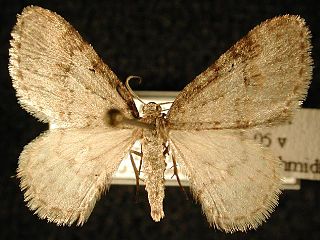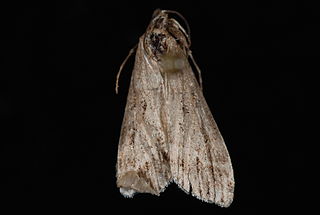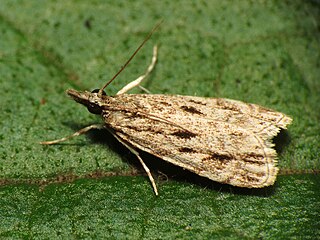
Arctia virginalis, the Ranchman's tiger moth, is a species of tiger moth in the family Erebidae. It was first described by Jean Baptiste Boisduval in 1852.

Eudonia is a large and widespread genus in the grass moth family (Crambidae), subfamily Scopariinae. There is no common name for the roughly 250 species placed here; new species are still being described regularly. Although the genus was proposed early in the 19th century, many of these moths were for a long time retained in Scoparia, the type genus of the subfamily and a close relative of Eudonia. A few small genera have been proposed for separation from Eudonia, but given the size of this group this is not particularly convincing; thus, all are retained here pending a comprehensive phylogenetic review.

Lobophora magnoliatoidata is a moth of the family Geometridae first described by Harrison Gray Dyar Jr. in 1904. It is found in western North America in Alberta, British Columbia, Yukon, the Northwest Territories, south through Washington to California.
Dioryctria cambiicola, the western pine moth, is a species of snout moth in the genus Dioryctria. It was described by Harrison Gray Dyar Jr. in 1914 and is found in North America from British Columbia and Alberta south to California and New Mexico.
Eupithecia casloata is a moth in the family Geometridae first described by Harrison Gray Dyar Jr. in 1904. It is found in North America, including Yukon, British Columbia, Alberta, Saskatchewan, New Brunswick, Newfoundland and Labrador, Quebec, Washington, Montana, Oregon, Wyoming, Colorado, Utah, California, Maine and New Hampshire.

Eupithecia spermaphaga is a moth in the family Geometridae first described by Harrison Gray Dyar Jr. in 1917. It is found in western North America from British Columbia, through Oregon and Washington to Nevada and California.

Venusia pearsalli, or Pearsall's carpet moth, is a moth in the family Geometridae. The species was first described by Harrison Gray Dyar Jr. in 1906. It is found in western North America, from Alaska, Alberta and British Columbia, through Washington and Oregon to California.
Spilosoma danbyi, or Danby's tiger moth, is a moth in the family Erebidae. It was described by Berthold Neumoegen and Harrison Gray Dyar Jr. in 1893. It is found in North America, where it has been recorded from Washington and western Canada from British Columbia to Manitoba.

Eudonia commortalis is a moth in the family Crambidae. It was described by Harrison Gray Dyar Jr. in 1921. It is found in North America, where it has been recorded from Alaska to British Columbia, Washington and California.

Eudonia albertalis is a moth in the family Crambidae. It was described by Harrison Gray Dyar Jr. in 1929. It is found in North America, where it has been recorded from Alberta to British Columbia, Washington, Idaho and Wyoming.
Eudonia excursalis is a moth in the family Crambidae. It was described by Harrison Gray Dyar Jr. in 1929. It is found in Costa Rica.
Eudonia inexoptata is a moth in the family Crambidae. It was described by Harrison Gray Dyar Jr. in 1929. It is found in Mexico.

Eudonia leucophthalma is a moth in the family Crambidae. It was described by Harrison Gray Dyar Jr. in 1929. It is found in North America, where it has been recorded from British Columbia and Alberta to Washington and California.
Eudonia vinasalis is a moth in the family Crambidae. It was described by Harrison Gray Dyar Jr. in 1929. It is found in Costa Rica.
Eudonia ycarda is a moth in the family Crambidae. It was described by Harrison Gray Dyar Jr. in 1929. It is found in Guatemala and Orizaba, Mexico.
Eudonia expallidalis is a moth in the family Crambidae. It was described by Harrison Gray Dyar Jr. in 1906. It is found in North America, where it has been recorded from Washington to Nevada and California.

Eudonia vivida is a moth in the family Crambidae. It was described by Eugene G. Munroe in 1972. It is found in North America, where it has been recorded from Alberta, British Columbia, Maine, New Hampshire, Nova Scotia and Quebec.

Eudonia spaldingalis is a moth in the family Crambidae. It was described by William Barnes and James Halliday McDunnough in 1912. It is found in North America, where it has been recorded from Alberta, Arizona, British Columbia, California, Colorado, Montana, Nevada, New Mexico, Utah and Wyoming.

Eudonia strigalis, the striped eudonia moth, is a moth in the family Crambidae. It was described by Harrison Gray Dyar Jr. in 1906. It is found in North America, where it has been recorded from Nova Scotia to southern Ontario and south to Florida.
Eudonia torniplagalis is a moth in the family Crambidae. It was described by Harrison Gray Dyar Jr. in 1904. It is found in North America, where it has been recorded from South Dakota, the Rocky Mountains, the mountains of the south-western United States and from British Columbia to southern California.











